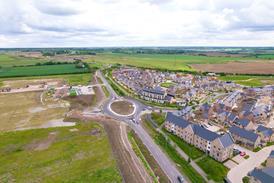Persimmon’s founder once embodied the bold spirit of the industry - a spirit Denise Chevin argues is now being stifled by rising costs, red tape and planning inflexibility
When Duncan Davidson died last month, the Daily Telegraph obituary captured something of a vanished world. A former page at Elizabeth II’s coronation, he joined George Wimpey as a trainee in 1963 before striking out on his own.
Two years later, armed with “money borrowed from his fiancée’s trust fund, the limited experience of his Wimpey apprenticeship and what he once called the arrogance of youth”, he launched Ryedale Homes in North Yorkshire. He sold it in 1972 and used the proceeds to found Persimmon, which became one of Britain’s best-known housebuilders and the first pure builder listed on the Stock Exchange.

At the Federation of Master Builders’ (FMB) launch of new guidance for SME developers, it was hard not to think of Davidson’s leap of faith – and how different things are for those trying to do the same today. He faced recessions, but the headwinds confronting small builders now are of a different order.
Section 106 agreements, the Community Infrastructure Levy, building safety rules, biodiversity net gain (BNG), the building safety levy, and utility connection charges all add layers of cost and delay. Together, they can total tens of thousands of pounds per home. The Future Homes Standard and landfill tax could add another £20,000 or more.
Construction costs have risen nearly 50% since 2016, while of late sale prices have stagnated. Development has slowed to a crawl: in the first half of 2025, only about 2,100 private homes were started in London – roughly 5% of the annual target. That’s not been helped by blockages in the Building Safety Regulator.
Large firms can spread costs across multiple sites. Small ones cannot.
Chris Carr, managing director of Carr & Carr (Builders) in Lincolnshire, notes that planning costs are just as high whether you are building 50 homes or 150 — regardless of the sale price. In fact according to the HBF the cost of planning fees even for small sites averaged £2m.
Promises, promises
The government insists that it want to help. In May, then deputy prime minister and housing secretary Angela Rayner called smaller housebuilders “the bedrock” of Labour’s plan to deliver 1.5 million homes this parliament. She promised simpler planning, lower taxes on very small sites, and easier access to Homes England loans – which she also increased.
So far, however, the sector has not felt the benefit – and Carr doubts that it will. According to an FMB report published in October, just 4% of housebuilders are accessing funding from Homes England.
Carr argues that Westminster still does not grasp how profoundly the economics have shifted. National builders can buy low-biodiversity greenfield land and make up the 10% BNG needed with landscaping. SMEs are often tackling awkward brownfield plots where values are lowest.
In Grimsby, a two-bed flat might sell for £125,000; in London, four or more times that – yet both must meet the same rules. Carr says BNG has been such a game changer that he has opted to turn one of his sites into a nature reserve to sell biodiversity credits, which was a more financially viable option than building the 200 homes he had once planned.
>> Also read: Will the expected London housebuilding package rescue the stalled development industry?
After nearly a century in business, Carr admits that his firm has had enough. He says development finance has become too complex and difficult to access. After 80 years with the same bank and a spotless repayment record, his firm was told that it no longer qualified for lending – simply because as an SME housebuilder it was too risky.
He would like smaller builders to be allowed to buy land collectively from Homes England and for financing to be simplified. Without that, he warns, more firms will bow out.
The numbers bear him out. The HBF says that in 2024, just 17,000 homes were approved on small sites of three to nine units – less than half the number a decade ago. The share of permissions for sites under 150 units has fallen from 20% in 2008 to around 7% today.
Carr reckons that SMEs now build only about 9% of new homes, and fears the Future Homes Standard could push more to quit: building two all-electric homes, he says, added £20,000 a piece to costs.
It is not just finance and red tape choking progress – it is planning inflexibility.
Kevin Wilson, a builder of bespoke homes now venturing into speculative development, says small changes to planning can make or break a project. On one site of six homes aimed at working families, planners in Morcambe would not allow him to reduce the garden size by a couple of metres which would have allowed an extra home. He ended up breaking even on the project but says he has got to build for the higher end to make development stack up.
Losing more than homes
The decline of the SME sector means losing more than output. These firms are embedded in their communities. Smaller firms train eight out of 10 construction apprentices, employ local labour, and source materials locally. They sponsor junior football teams and give young tradespeople their first jobs. When they vanish, so does the ecosystem that sustains skills and local economies.
They also tend to build smaller, better-integrated schemes which fit their surroundings – the infill projects that large developers overlook.
There are growth success stories. Firms such as Hill and Telford Homes have thrived by adopting mixed-tenure or build-to-rent models, and forming partnerships to keep schemes viable even in a higher-cost environment. But those routes have been narrowing too.
As things stand, Britain cannot rely on SME growth to deliver more than a fraction of those extra homes. The foundations beneath the small-builder model have cracked too deeply for many
Housing associations and councils – potential partners in such ventures – have diverted funds into meeting Building Safety and Awaab’s Law obligations, leaving less appetite for new development.
Nick Cuff, founder of Urban Sketch, believes the whole system needs shaking up. He points to New Zealand’s “zonal” model, where pre-approved development parameters streamline planning and reduce risk. Something similar, he argues, could help smaller UK builders to compete on fairer terms.
What’s the big idea?
The government remains committed to its 1.5 million homes pledge. But, with the SME base eroding, how will it get there? Will Keir Starmer borrow from Andy Burnham’s idea of nationalising housebuilding. Not the full monty of course, but start commissioning off-site manufacturers to ramp up production and using public land for standardised homes built from a “kit of parts”?
Ministers already promote a “platform approach” for schools; perhaps housing is next – and, who knows, perhaps it could piggy back on the newly announced military housing quango? I know, I know – there are a thousand reasons why it won’t work, you say.
But, as things stand, Britain cannot rely on SME growth to deliver more than a fraction of those extra homes. The foundations beneath the small-builder model have cracked too deeply for many.
The spirit that defined Duncan Davidson and Ryedale Homes is being snuffed out by bureaucracy, levies and finance barriers before the first brick has been laid. Unless the government finds a way to rebuild that confidence – through simpler planning, accessible finance, and policies that reflect regional realities – and prioritising what it really wants (more homes or net zero, perhaps?) and at least pauses loading more costs into the system, it is hard to see where Britain’s next Duncan Davidsons will come from.
Denise Chevin is a writer and policy advisor in the built environment, utilities and technology. She is the former editor of Building and Housing Today



























No comments yet